 Here’s the latest essay by Matti Vooro. Like Ed Caryl, Matti has written some very successful essays. At least two of them have been translated in German and posted at German sites.
Here’s the latest essay by Matti Vooro. Like Ed Caryl, Matti has written some very successful essays. At least two of them have been translated in German and posted at German sites.
============================
Are European Winters Going To Stay Warm? By Matti Vooro
North America’s winters have been getting colder since 2006, and Europe had its two warmest winters ever in 2007 and 2008 as the AO, NAO and AMO were all positive. All this may be changing over the next several decades. Cooling was already evident after 2007 as both the winter AO and NAO went negative.
Figure 1 shows the European winter temperature departures, land and sea, for years 1948 -2009. The graph shows above normal temperature anomalies in the period 1948-1964, followed by a cooler period 1962-1987 when the temperature anomalies were mostly below normal except when they were briefly interrupted by a warm period in the first half of the 1970’s due to a number of years with a warm or positive AO. This was then followed by a warm period 1987-2007. Winter temperatures started to decline after 2007.
Figure 2 shows again the European winter temperature departures (land and sea) together with the winter AO and winter AMO Indices. Europe‘s climate seems to be significantly affected by AO and AMO. The drop in winter temperature deviations as the winter AO went strongly negative is especially noticeable in the winters of 2009, 2010 and 2011. AMO is still positive or warm.
Figure 3 shows a correlation between winter NAO and winter AO and both are reflected in the European winter temperatures. One is a subset of the other. The negative phase of NAO implies high pressure anomaly over Iceland, low pressure anomaly over sub-tropical Atlantic, weakened mid-latitude easterlies, colder over Northern Europe, milder over Greenland, colder and snowier for eastern US. This was the dominant phase from the mid 1950s through late 1970s. The negative AO, NAO and AMO seem to be returning.
The annual and monthly AO data can be found here.
The figures below show how the variation in the number of negative or cool winter NAO’s affected the cool and warm periods in the past.
1920 – 1940: 9 negative or cool winter NAO years [WARM PERIOD]
1950 – 1970: 14 negative or cool winter NAO years [COLD PERIOD]
1980 – 2009: 8 negative or cool winter NAO years [WARM PERIOD]
Figure 4 supplied by the NOAA shows the change in the winter AO from basically being positive from 1989 to 2008 to now becoming strongly negative.
Source: NOAA
Last cool period for Europe
Figure 5 shows the European winter temperature [land and sea] and the winter AO index for the years 1962-1987, the last cool period in Europe. During this time 17 or 2/3 of the winters were below norm and had an average mean temperature departure of -0.14°C (range of -1.28°C to +0.93°C). During the 22 years after this period , the average mean winter temperature was + 0.63°C with a range of +1.54°C to -0.27° C.
Recent historical European winter temperature departures from 1961-1990 base for the years 1998 -2009
Figure 6 shows the European winter temperature departure [land and sea] and the winter AO and AMO index more recently for the years 1998 -2008. Notice that there has been no significant increase in temperature departures other than 2007-2008 and the temperature anomalies have actually started to decline as the AO stared to decline after 2007 and have done so for the last 3 years and possibly 4 years if 2011 is
I have estimated the 2010 winter anomaly. It is bound to be negative as UK 2010 winter temperature dropped by 1.57 °C over 2009. Table of recent historical European winter temperature departures (land and sea) from 1961-1990 base for the years 1998 -2009
1998 1.23°C
1999 0.45
2000 0.63
2001 1.12
2002 0.67
2003 -0.06
2004 0.65
2005 0.60
2006 0.12
2007 1.54
2008 1.34
2009 0.52
2010 -1.0 (estimated, not available until May 2011)
2011 not available
The average mean winter temperature anomaly during this most recent period of 1998 to2009 was 0.73°C while during the previous cooler period it was – 0.14°C or almost a full degree cooler. La Nina winters have not been exceptionally cold for Europe. Seven of the last La Nina winters have been above normal and the average anomaly for the last four was o.89°C well above the 0.73°C average above. The 2011 winter anomaly will be down because of the cold December 2010
Data source
All of the above European winter temperature departure data can be found at the following web page of European Environment Agency.
Final comments
I find no evidence in the field during the post 2007 period to support the IPCC prediction that “The warming in northern Europe is likely to be largest in winter…”. The flat global temperatures for the last 10 years and the recent cooling since about 2006-2007 seem to be consistent with the cooling taking place now all over Northern Hemisphere, including Europe, as the natural planetary cycles enter their cool mode. Once the North Atlantic ocean SST and AMO start to contribute to the global cooling in a more significant way, the global temperatures of the western coast of Europe and the Arctic will be the cooling more consistently. This cooler period could last 30 years as they have done nearly 20 times during the last 500 years.
Matt Vooro, P.Eng
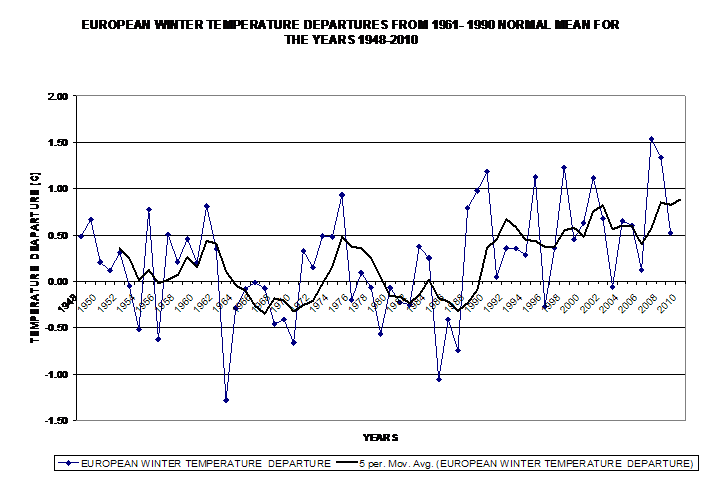
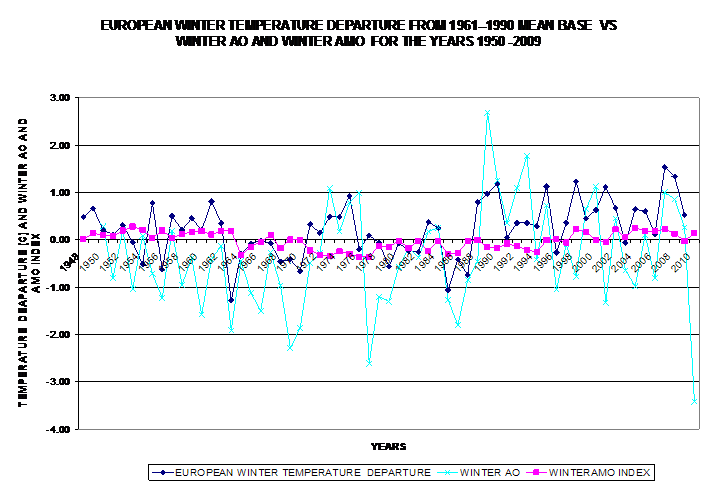
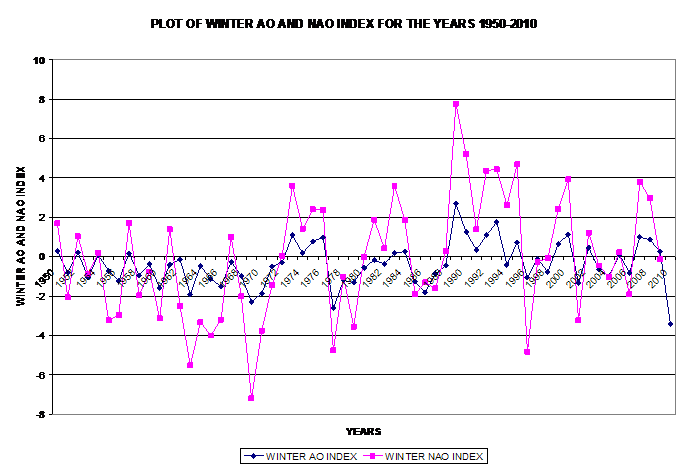
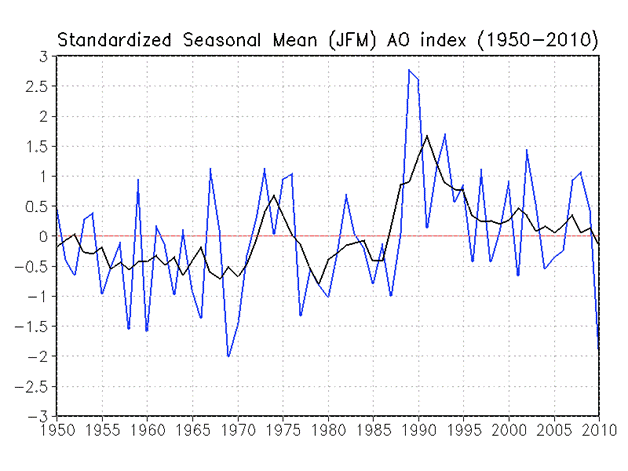
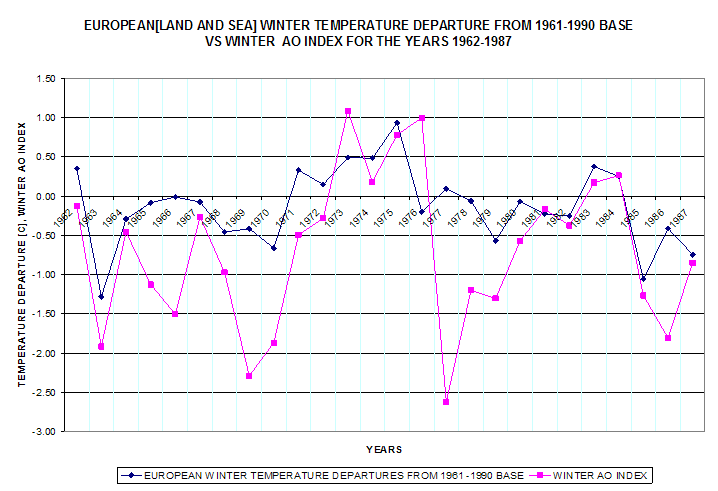
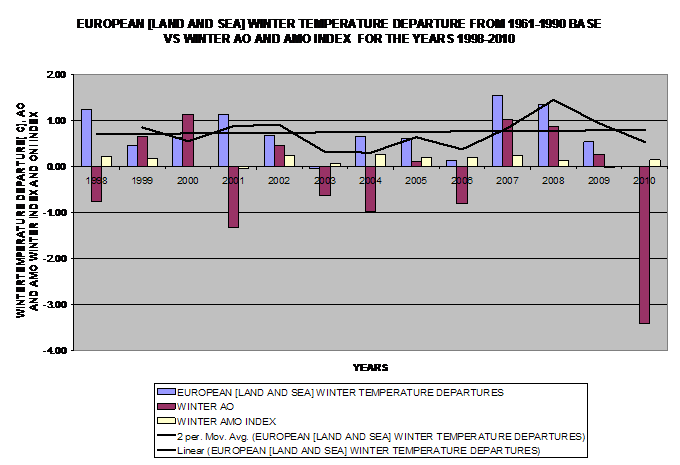





Good job Matti. This clearly indicates that the climate follows along bigger things like oceans, and that CO2 plays a minor role only.
Good stuff. Analyzing the winter and summer CET temperatures, I have found good fit between AMO and summer temperatures and NAO/AO and winter temps. Both cycles peaked in 90/00-ties.
It is very telling, how IPCC AR4 treats NAO/AO:
http://www.ipcc.ch/publications_and_data/ar4/wg1/en/ch11s11-8-1.html
It says warming has coincided with positive phase of NAO, models say it will stay warm forever, reality shows it does not, result for policymakers – CO2 causes warming.
juraj v
You can do a similar summer analysis for Europe as you did for CET. The European Enviornment Agency web reference shows summer, winter and annual temperature deviations for land only or for land and sea and the NOAA web page gives the AO in tabular form showing each month for each year 1950-2010. Jim Hurrel provides the best NAO [ see CGD’S CLIMATE ANALYSIS SECTION : JIM HURREL
I have not done the summer analysis but if you have , I believe you.
Matti, I have my doubts about the official European record, since it is obviously plagued by UHI. Up to now, all rural stations I have found show 1940s just a tiny bit colder than 2000s.
CET consists also of urban stations, but it is corrected for UHI somehow and has a long record, that’s why I used it for my analysis.
This is source for NAO that I was referring to earlier
http://www.cgd.ucar.edu/cas/jhurrell/indices.html
For some quick background material on AMO, NAO and AO
http://www.appinsys.com/GlobalWarming/AO_NAO.htm
http://www.appinsys.com/GlobalWarming/AMO.htm
http://bobtisdale.blogspot.com/2010/08/introduction-to-enso-amo-and-pdo-part-2.html
RE: “1920 – 1940: 9 negative or cool winter NAO years [WARM PERIOD]
1980 – 2009: 8 negative or cool winter NAO years [WARM PERIOD]
I find no evidence in the field during the post 2007 period to support the IPCC prediction that “The warming in northern Europe is likely to be largest in winter…”.”
Hi Matti Vooro,
from the number of neg.NOA 1920- 40 and 1980-2009 are fairly identical, but both periods showed up differently. The first was primarily an Arctic warming and was highly confined to the winter period, lasting in USA only until 1933, in Europe until winter 1939/40:
http://www.arctic-warming.com/poze/pozaB.jpg
http://www.arctic-warming.com/poze/pozaK3.jpg
http://www.arctic-warming.com/poze/pozaG1.jpg
For the more recent period it seems it was much less pronounced, but nevertheless, the winters at higher latitude are warmer, see Fig 1 & 2 at:
http://diggingintheclay.wordpress.com/2010/10/27/noaa-%E2%80%9Carctic-report-card-update-for-2010%E2%80%9D/
Regards
Isn’t the internet great?
http://stevengoddard.wordpress.com/2011/02/07/overland-less-snow-overland-more-snow/
We are entering a colder times although the core of the cold will be found more to the east. As the AMO cools down we will have colder winters
in the West. It’s just a matter of time but the big scale process going on is very clear. Our oceans continue to cool, our sun is sputtering along at solar minimum. All we need is a substantial volcanic eruption and we’re back in Little Ice Age territory.
Also have a read at this article from Joseph D’Aleo
Record Hemispheric snow but moisture content BELOW normal
http://icecap.us/index.php/go/joes-blog
That slabs the arguments out of the hands of the warmists all right.
ArndB
Good comments. My comments with respect to lack of warming applied to the post 2007 period and to the Eurpean region only. I live in Canada and and we have a very cold and snowy weather inland , moderate and very wet west coast, stormy and snowy east coast , a warmer than normal Arctic region and cold and snowy weather coming from the south[ US]. A national Canadian temperature anomaly for the winter is now a days meaningless as no region in Canada matches this derived temperature region. It is difficult to make comparisons. My message is that I think we are just as likely to head for cooler weather, especially in the Northern Hemisphere as opposed to straight line unprecedented warming only. Regionally all sort of different patterns could emerge and fluctuate all over the place.
R. de Haan
When IPCC predicts for North America,
“Snow season length and snow depth are very likely to decrease in most of North America, except in the northernmost part of Canada where maximum snow depth is likely to increase. ” and one looks at the snow extent record for all of North America which has been increasing for about 4-5 years , the lack credibility of the IPCC science and their predictions becomes more obvious and blogs such as this need to speak up.
Here is the graph showing the growth in snow extent in North America. Notice the increases the last 4 years . This winter it may be even higher?
http://climate.rutgers.edu/snowcover/chart_seasonal.php?ui_set=namgnld&ui_season=1
I took a look at Moscow to see if the global cooling is also happening in Russia and parts of Asia. We all know how cold it can get in Russia. During the last 20 years [1990-2010] of warmer winters in Russia, there were only four [or 20% of the winters ] as very cold winters with winter temperatures around – 9 to-10C , but during the 30 years prior to the warmer period or 1960-1990 , 15 or 50% of the winters were very cold . Decembers have been getting colder now for 4 years in a row as have their winters. January 2010 winter was the coldest since 1987. I have not seen the figures for 2011. Winter AO and winter NAO correlate again with Moscow winter temperatures as do they correlate for most of Europe. By the way during the cold winters of the Second World War1940-1942 it got down to -20.3 C in Jan 1942 in Moscow, so it makes the – 0.7 C that completely crippled UK this past December2011 sound like Florida.
Thanks for your previous comment (8. Februar 2011 at 15:03).
The winters 1939/40 to 1941/42 have a lot to offer for climate change research, and Moscow was in the cold several times, particularly in Jan/Feb. 1942, but presumably for the first time in the war on:
____17 January 1940; Moscow. Severe cold continued in Moscow today, the average morning temperature being 49 degrees below zero Fahrenheit (-45°C). (NYT, 18 January 1940).
More about the three winters at: http://climate-ocean.com/
During the three years many more cold records established, e.g. Oslo January 1941 (ca. –26°C).
____AND the all time record in Hamburg, minus 29,1°C on 13 February 1940; today (09 Feb.) we expect here max. +6°, min.+1°.
Arnd B
Thanks for the excellent reference . I was still in Europe during that time and my father was deported to Siberia during that same cold period . I have often wondered what he must have gone through during that extremely cold period locked up in a unheated rail car.
Forget the evidence and just focus only on the hypothetical future no matter 10 cold winters in a row. Ignore the facts and focus on the alarm.
/SARC